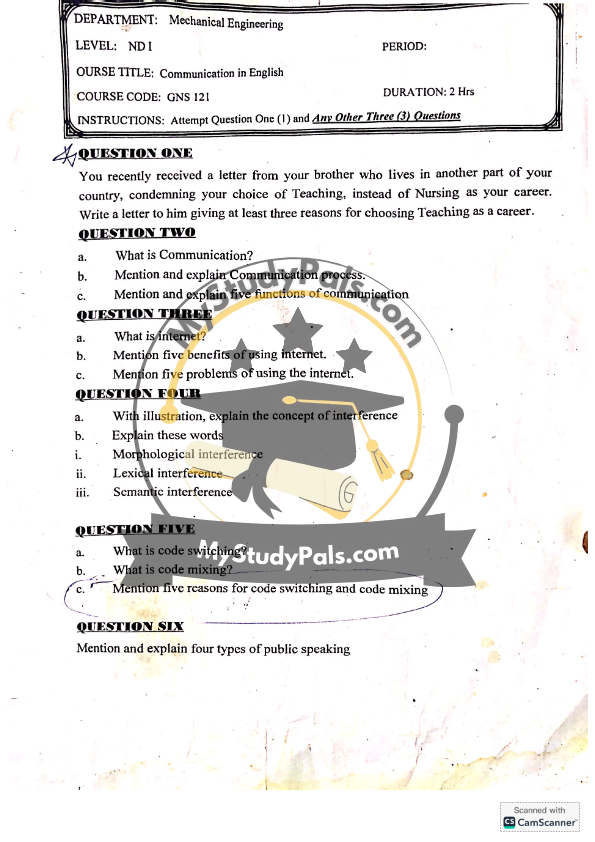 ANSWER
ANSWER
Question 1:
Dear Brother,
I understand your concerns about my choice of Teaching as a career instead of Nursing. However, I have carefully considered my decision and would like to share three reasons why I chose Teaching:
- Passion for Education – I have always had a passion for imparting knowledge and shaping young minds. Teaching allows me to inspire and guide students toward a better future.
- Job Security and Stability – Teaching provides stable employment opportunities with benefits such as pensions and career growth. It is a respected profession that will always be in demand.
- Impact on Society – Teachers play a crucial role in shaping society by educating future leaders. Through teaching, I can contribute to the intellectual and moral development of students.
I hope you understand my choice and support me in this journey.
Best regards,
[Your Name]
Question 2:
a. What is Communication?
Communication is the process of exchanging information, ideas, thoughts, and emotions between individuals or groups through verbal, non-verbal, or written means.
b. Communication Process
The communication process consists of the following elements:
- Sender – The person who initiates the message.
- Message – The information being conveyed.
- Encoding – The process of converting the message into symbols or words.
- Channel – The medium used for communication (e.g., speech, text, email).
- Receiver – The person who receives and interprets the message.
- Decoding – The process of interpreting the message.
- Feedback – The response from the receiver to ensure understanding.
c. Five Functions of Communication
- Informative Function – Provides information and knowledge.
- Expressive Function – Allows individuals to express emotions.
- Directive Function – Guides or influences others’ actions.
- Social Function – Helps in building relationships.
- Persuasive Function – Used to convince or persuade others.
Question 3:
a. What is the Internet?
The Internet is a global network of interconnected computers that enables the exchange of information and communication through various digital platforms.
b. Five Benefits of Using the Internet
- Easy Access to Information – Provides a vast source of knowledge.
- Global Communication – Allows instant communication worldwide.
- E-commerce – Facilitates online shopping and transactions.
- Entertainment – Offers access to music, videos, and games.
- Online Learning – Enables distance education and skill development.
c. Five Problems of Using the Internet
- Cybercrime – Increases risks of hacking and fraud.
- Misinformation – Spread of fake news and false data.
- Addiction – Overuse leading to reduced productivity.
- Privacy Issues – Data theft and personal security concerns.
- Health Problems – Eye strain and poor posture due to prolonged use.
Question 4:
a. Concept of Interference (with Illustration)
Interference in communication occurs when external factors distort or obstruct the message, leading to misinterpretation.
Example: A poor phone connection making a conversation unclear.
b. Explanation of Terms
i. Morphological Interference – The influence of one language’s word formation rules on another language.
ii. Lexical Interference – The use of words from one language while speaking another, often resulting in incorrect usage.
iii. Semantic Interference – Misinterpretation of meaning due to language differences.
Question 5:
a. What is Code Switching?
Code switching is the practice of alternating between two or more languages or language varieties within a conversation.
b. What is Code Mixing?
Code mixing occurs when elements from two languages are blended within a sentence or phrase without switching completely.
c. Five Reasons for Code Switching and Code Mixing
- Lack of Vocabulary – When a speaker does not know the correct word in one language.
- Emphasis – To stress a point using another language.
- Cultural Identity – To maintain a connection with one’s heritage.
- Comfort and Habit – When switching feels more natural.
- Social Status – To demonstrate knowledge of multiple languages.
Question 6:
Four Types of Public Speaking
- Informative Speaking – Provides knowledge and facts on a topic.
- Persuasive Speaking – Aims to influence or convince the audience.
- Entertaining Speaking – Engages the audience with humor and storytelling.
- Inspirational Speaking – Motivates and encourages listeners.

